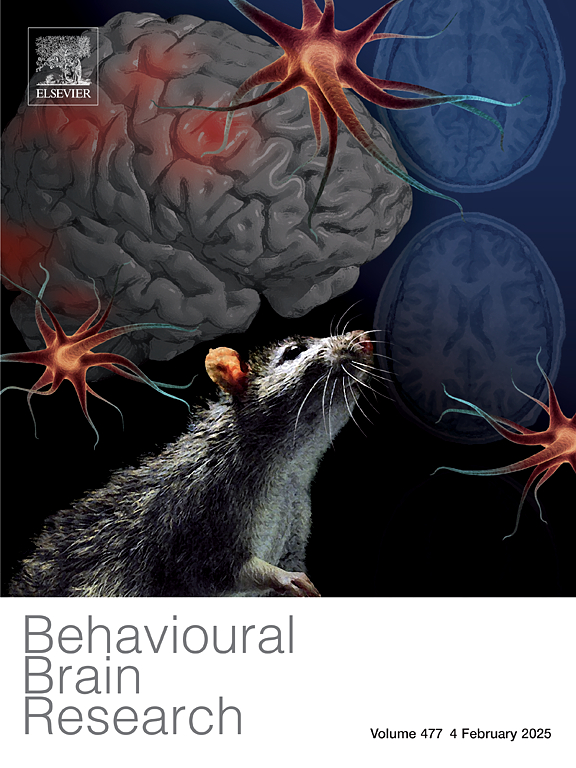Low-grade chronic inflammatory stimulation alleviates α‑syn accumulation in Parkinson's disease by activating autophagy to promote neuronal survival in the Thy1-h[A30P]α-syn mouse model
IF 2.6
3区 心理学
Q2 BEHAVIORAL SCIENCES
引用次数: 0
Abstract
The impact of inflammation on Parkinson's disease (PD) development and progression varies based on factors such as the intensity, duration of inflammation, and the disease stage. Delving deeper into this aspect could unveil novel therapeutic opportunities for PD treatment. (Thy-1)-h[A30P]α-syn mice were used as PD animal models. Low-grade chronic inflammatory stimulation was applied by the treatment of lipopolysaccharide (LPS) or monophosphoryl lipid (MPL). RT-qPCR, western blotting, IHC, and IF staining were utilized to confirm the relative expression of targeted genes and proteins. Assay kits were used to determine the levels of Cathepsin B (CTSB) activities. The motor function of the mice was assessed by pole-climbing test and field test. Mild inflammatory stimulus activated microglia without elevating their secretion of inflammatory cytokines. This stimulation also induced activation of autophagy, and facilitated the degradation of α-syn in the midbrain by triggering the autophagy-lysosome pathway, thereby fostering neuron survival. Low-grade inflammatory stimulation promoted α-syn degradation via the autophagy-lysosome pathway. These findings offer new perspectives for the treatment of PD.
在Thy1-h[A30P]α-syn小鼠模型中,低级别慢性炎症刺激通过激活自噬促进神经元存活,减轻帕金森病中α-syn的积累。
炎症对帕金森病(PD)发展和进展的影响取决于炎症的强度、持续时间和疾病分期等因素。对这方面的深入研究可能会为帕金森病的治疗带来新的治疗机会。以(Thy-1)-h[A30P]α-syn小鼠作为PD动物模型。通过脂多糖(LPS)或单磷酰脂质(MPL)治疗,应用低级别慢性炎症刺激。采用RT-qPCR、western blotting、IHC、IF染色等方法确认靶基因和蛋白的相对表达。采用检测试剂盒检测组织蛋白酶B (CTSB)活性水平。采用爬杆试验和野外试验评价小鼠的运动功能。轻度炎症刺激激活了小胶质细胞,但不增加其炎症细胞因子的分泌。这种刺激还诱导了自噬的激活,通过触发自噬-溶酶体通路,促进了中脑α-syn的降解,从而促进了神经元的存活。低级别炎症刺激通过自噬-溶酶体途径促进α-syn降解。这些发现为帕金森病的治疗提供了新的视角。
本文章由计算机程序翻译,如有差异,请以英文原文为准。
求助全文
约1分钟内获得全文
求助全文
来源期刊

Behavioural Brain Research
医学-行为科学
CiteScore
5.60
自引率
0.00%
发文量
383
审稿时长
61 days
期刊介绍:
Behavioural Brain Research is an international, interdisciplinary journal dedicated to the publication of articles in the field of behavioural neuroscience, broadly defined. Contributions from the entire range of disciplines that comprise the neurosciences, behavioural sciences or cognitive sciences are appropriate, as long as the goal is to delineate the neural mechanisms underlying behaviour. Thus, studies may range from neurophysiological, neuroanatomical, neurochemical or neuropharmacological analysis of brain-behaviour relations, including the use of molecular genetic or behavioural genetic approaches, to studies that involve the use of brain imaging techniques, to neuroethological studies. Reports of original research, of major methodological advances, or of novel conceptual approaches are all encouraged. The journal will also consider critical reviews on selected topics.
 求助内容:
求助内容: 应助结果提醒方式:
应助结果提醒方式:


